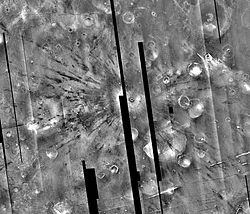- Ray system
-
A ray system comprises radial streaks of fine ejecta thrown out during the formation of an impact crater, looking a bit like many thin spokes coming from the hub of a wheel. The rays can extend for lengths up to several times the diameter of their originating crater, and are often accompanied by small secondary craters formed by larger chunks of ejecta. Ray systems have been identified on the Moon, Mercury, and some moons of the outer planets. Originally it was thought that they existed only on planets or moons lacking an atmosphere, but more recently they've been found on Mars in infrared images taken from orbit by Mars Odyssey's thermal imager.
Rays appear at visible, and in some cases infrared wavelengths, when ejecta are made of material with different reflectivity (i.e., albedo) or thermal properties from the surface on which they are deposited. Typically, visible rays have a higher albedo than the surrounding surface. More rarely an impact will excavate low albedo material, for example basaltic-lava deposits on the lunar maria. Thermal rays, as seen on Mars, are especially apparent at night when slopes and shadows do not influence the infrared energy emitted by the Martian surface.
The layering of rays across other surface features can be useful as an indicator of the relative age of the impact crater, because over time various processes obliterate the rays. On non-atmosphered bodies such as the Moon, space weathering from exposure to cosmic rays and micrometeorites causes a steady reduction of the differential between the ejecta's albedo and that of the underlying material. Micrometeorites in particular produce a glassy melt in the regolith that lowers the albedo. Rays can also become covered by lava flows, or by other impact craters or ejecta.
Lunar rays
The physical nature of lunar rays has historically been a subject of speculation. Early hypotheses suggested that they were deposits of salt from evaporated water. Later they were thought to be deposits of volcanic ash or streaks of dust. After the impact origin of craters became accepted, Eugene Shoemaker suggested during the 1960s that the rays were the result of fragmented ejecta material.
Recent studies suggest that the relative brightness of a lunar ray system is not always a reliable indicator of the age of a ray system. Instead the albedo also depends on the portion of iron oxide (FeO). Low portions of FeO result in brighter materials, so such a ray system can retain its lighter appearance for longer periods. Thus the material composition needs to be factored into the albedo analysis to determine age.
Among the lunar craters on the near side with pronounced ray systems are Aristarchus, Copernicus, Kepler, Proclus, and Tycho. Similar ray systems also occur on the far side of the Moon, such as the rays radiating from the craters Giordano Bruno and Ohm.
References
- Martel, L.M.V. (Sept., 2004) Lunar Crater Rays Point to a New Lunar Time Scale, Planetary Science Research Discoveries. http://www.psrd.hawaii.edu/Sept04/LunarRays.html. (Accessed 9/15/2005)
- Burnham, R. (March, 2005) Chipping pieces off Mars: Martian craters with rays may be the long-sought sources for the Mars meteorites found on Earth, Astronomy Magazine Online. http://www.astronomy.com/asy/default.aspx?c=a&id=2980 (Accessed 8/07/2006)
See also
Categories:- Impact craters
Wikimedia Foundation. 2010.



